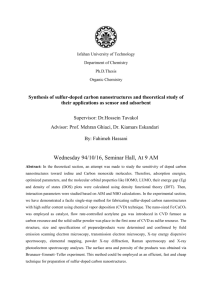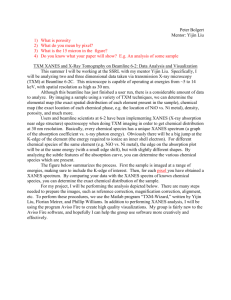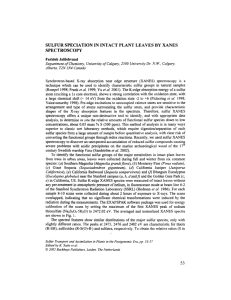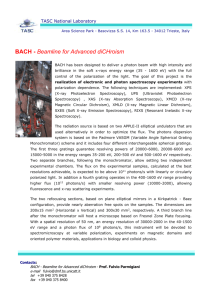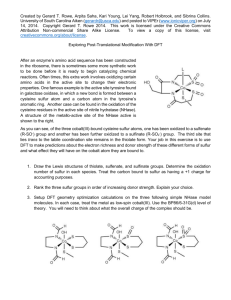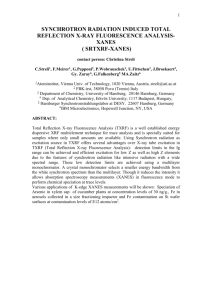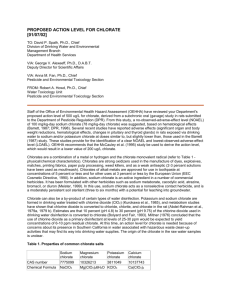emi412156-sup-0001-si
advertisement
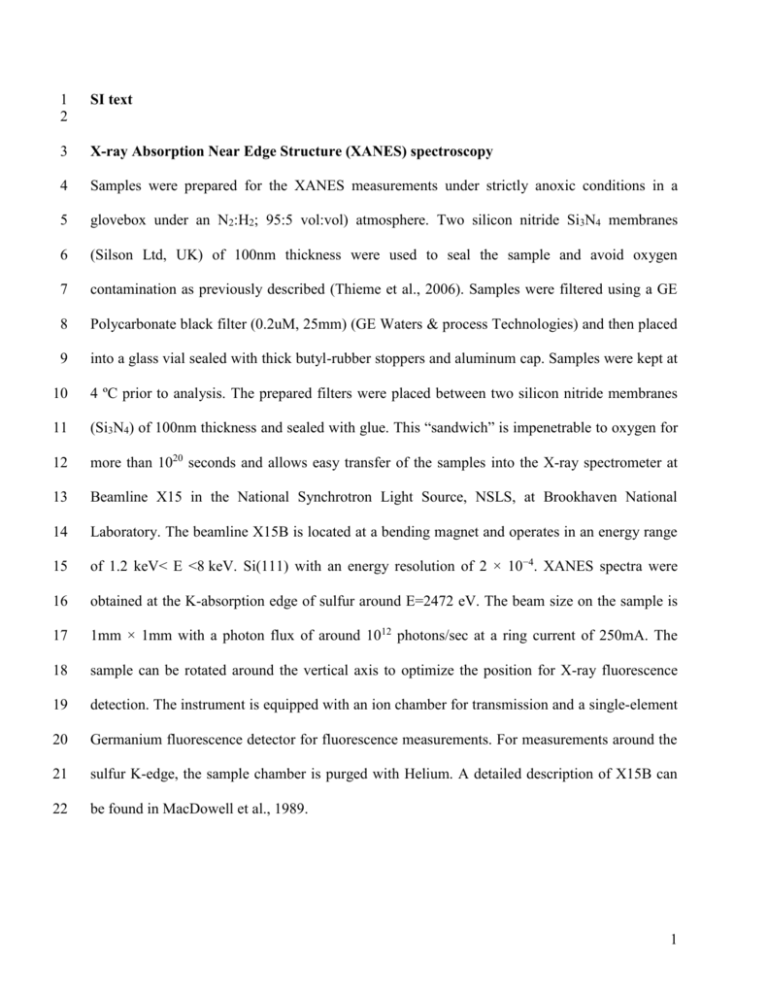
1 2 SI text 3 X-ray Absorption Near Edge Structure (XANES) spectroscopy 4 Samples were prepared for the XANES measurements under strictly anoxic conditions in a 5 glovebox under an N2:H2; 95:5 vol:vol) atmosphere. Two silicon nitride Si3N4 membranes 6 (Silson Ltd, UK) of 100nm thickness were used to seal the sample and avoid oxygen 7 contamination as previously described (Thieme et al., 2006). Samples were filtered using a GE 8 Polycarbonate black filter (0.2uM, 25mm) (GE Waters & process Technologies) and then placed 9 into a glass vial sealed with thick butyl-rubber stoppers and aluminum cap. Samples were kept at 10 4 ºC prior to analysis. The prepared filters were placed between two silicon nitride membranes 11 (Si3N4) of 100nm thickness and sealed with glue. This “sandwich” is impenetrable to oxygen for 12 more than 1020 seconds and allows easy transfer of the samples into the X-ray spectrometer at 13 Beamline X15 in the National Synchrotron Light Source, NSLS, at Brookhaven National 14 Laboratory. The beamline X15B is located at a bending magnet and operates in an energy range 15 of 1.2 keV< E <8 keV. Si(111) with an energy resolution of 2 × 10−4. XANES spectra were 16 obtained at the K-absorption edge of sulfur around E=2472 eV. The beam size on the sample is 17 1mm × 1mm with a photon flux of around 1012 photons/sec at a ring current of 250mA. The 18 sample can be rotated around the vertical axis to optimize the position for X-ray fluorescence 19 detection. The instrument is equipped with an ion chamber for transmission and a single-element 20 Germanium fluorescence detector for fluorescence measurements. For measurements around the 21 sulfur K-edge, the sample chamber is purged with Helium. A detailed description of X15B can 22 be found in MacDowell et al., 1989. 1 23 Taking the complexity of the sample under investigation and of XANES spectra in general into 24 account, constraining assumptions had to be made with respect to the fitting approach in order to 25 achieve consistent results. 26 All data were analyzed using standardized techniques. Raw spectra were baseline-corrected, 27 normalized to the edge jump, and smoothed with the Golay–Savitzky algorithm, using an 28 interval length of 5 points in both directions from the central point and a fifth grade polynom. 29 Major components were fitted into the spectrum, using a combination of Gaussian and 30 Lorentzian analysis for each component. The ratio of Gaussian to Lorentzian was optimized at 31 0.6 based on iterative determinations. Absorption spectroscopy lines are asymmetric and can be 32 described in theory using Lorentzian analysis. However, instrumental influences broaden the 33 line. These influences are symmetrical and are best described using Gaussian analysis. A 34 convolution of both, Lorentzian and Gaussian provides the optimum approach for fitting a 35 spectrum. Arctangent functions were used to describe edge jumps. As each sulfur species can be 36 presumed to be independent from others, an arctangent function was assigned to every peak. The 37 width of the arctangent function was set to 1 eV, the height relative to the peak height was set to 38 approximately 0.15. All analytical operations were performed using the program Specfit (Gleber 39 et al., 2003). A diluted sulfate solution was used for calibration, for which the spectrum showed 40 the peak position of the sulfate S at E = 2483.5 eV. Using the well accepted value of E = 2482.5 41 eV from literature (Huffmann et al. 1991, Prietzel et al. 2007), all measured spectra were 42 corrected accordingly. After that correction, the various sulfur species in the samples were 43 identified by comparing the maximum energies of the fitted peaks to well-known white-line 44 energies of different standard compounds, taken from literature. The absorption cross section of 45 the S white line peak is proportional to the number of 3p orbital vacancies in a single one- 2 46 electron model, and thus increases as the oxidation state of the S atom increases (Xia et al., 47 1998). Therefore, the contribution of S species with different electronic oxidation states of the S 48 atoms to total S can be determined by correcting the measured peak areas with the respective 49 absorption cross section., 50 51 52 53 54 55 56 57 58 59 60 61 62 63 64 65 66 67 68 69 70 71 72 73 Gleber, G., J. Thieme, J. Niemeyer, and M. Feser. 2003. Interaction of organic substances with iron studied by O1s spectroscopy - Development of an analysis program. J Phys IV 104: 31533168. Huffman, G., S. Mitra, F. E. Huggins, N. Shah, S. Vaidya, and F. Lu. 1991. Quantitative Analysis of All Major Forms of Sulfur in Coal by X-ray Absorption Fine Structure Spectroscopy. Energy & Fuels 5:574-581. MacDowell, A. A., T. Hashizume, and P. H. Citrin. 1989. A soft/hard x-ray beamline for surface EXAFS studies in the energy range 0.8-15 keV. Review of Scientific Instruments 60:1901-1904. Prietzel, J., J. Thieme, M. Salome, and H. Knicker. 2007. Sulfur K-edge XANES spectroscopy reveals differences in sulfur speciation of bulk soils, humic acid, fulvic acid, and particle size separates. Soil Biology & Biochemistry 39:877-890. Thieme, J., J. Prietzel, N. Tyufekchieva, D. Paterson, and I. McNulty. 2006. Speciation of sulfur in oxic and anoxic soils using x-ray spectromicroscopy. IPAP Conference Series 7:318-320. Xia K., F. Weesner, W. F. Bleam, P. R. Bloom, U. L. Skyllberg, and P. Helmke. 1998. XANES Studies of Oxidation States of Sulfur in Aquatic and Soil Hunlic Substances. Soil Sci. Soc. Am. J. (1998) 62, pp. 1240-1246 74 75 Isotopic fractionation 76 Isotopic fractionation analysis was performed looking at the ratios of 77 elemental sulfur. Dissolved sulfide samples were precipitated by adding AgNO3. The Ag2S 78 formed was purified and washed with NH4OH and deionized water. Elemental sulfur samples 79 were rinsed with ethanol and deionized water. All samples were dried prior to analysis. Isotope 80 ratios were measured using a Eurovector model 3028 elemental analyzer in helium continuous 34 S to 32 S in sulfide and 3 81 flow mode interfaced with a GV Isoprime isotope ratio mass spectrometer. Isotope ratios are 82 reported in delta notation: δ34S (‰) = 1000([34S/32S]sample /[34S/32S]standard -1). 83 84 Transmission Electron Microscopy imaging 85 Bacteria, from a 0.53 OD600nm growth suspension, were added undiluted to 100-400 mesh 86 carbon-coated and glow-discharged grids for imaging. The solution was blotted off, and a dilute 87 trehalose solution was applied for 30s. The solution was then blotted again and stored at room 88 temperature until imaging. Grids were imaged in a JEOL JEM-1200 electron microscope 89 operated at 120 kV at 5000X nominal magnification. Images were recorded with a Gatan 90 1024x1024-pixel CCD camera (Gatan, Inc.). 91 92 93 4 94 18 a 0.4 14 12 0.3 10 8 Lactate Chlorate OD 600nm 6 4 0.2 0.1 2 0 0 0 5 10 95 15 20 Time (hr) 25 30 35 SI Figure 1a. Growth coupled to lactate oxidation and chlorate reduction by a reinoculated culture of A. suillum in unfiltered spent broth after the initial sulfide oxidation was complete. The results depicted are the average of triplicate cultures. 18 0.4 14 12 0.3 10 101 102 103 104 8 Lactate Chlorate OD 600nm 6 4 0.2 OD 600nm Chlorate and Lactate consumption (mM) 0.5 b 16 100 OD 600nm Chlorate and Lactate consumption (mM) 16 96 97 98 99 0.5 0.1 2 0 0 0 10 20 Time (hr) 30 40 SI Figure 1b. Growth coupled to lactate oxidation and chlorate reduction by a reinoculated culture of A. suillum in 0.22m filtered spent broth after the initial sulfide oxidation was complete. The results depicted are the average of triplicate cultures. 5 105 106 107 108 109 0.5 10 0.4 8 0.3 6 Lactate Chlorate OD 600nm 4 0.2 OD 600nm Chlorate and Lactate consumption (mM) 12 0.1 2 0 0 0 10 20 30 40 Time (hr) 50 60 70 SI Figure 2. Growth coupled to lactate oxidation and chlorate reduction by the static H2Soxidizing culture of A. suillum when it is used to inoculate fresh BM amended with lactate (10mM) and chlorate (10mM) 110 111 112 113 114 115 116 117 118 Gregoire et al – SI Figure 2 6 119 120 121 122 123 124 125 126 127 128 129 130 131 132 133 134 135 136 137 138 139 140 141 142 143 144 145 146 147 148 149 150 151 152 153 154 155 156 157 158 159 XANES analysis T0 XANES analysis T24 SI Figure 3. XANES spectroscopy of washed culture retentate of A. suillum initially and after 24 hours incubation in the presence of H2S and chlorate. 7 160 161 162 163 164 165 166 167 168 169 170 171 SI Figure 4. EDX spectra confirming three sulfur inclusions in A. sullium on the carbon film support. Chemical analyses of the whole mount bacterial cell TEM samples were carried out in a JEOL 2100-F 200 kV Field-Emission Analytical Transmission Electron Microscope (TEM) equipped with Oxford INCA Energy Dispersive Spectroscopy (EDX) X-ray detection system at the Molecular Foundry at LBL. EDX spectra were acquired for 60 live seconds with a 0.4 μm probe at 200 kV. 8
